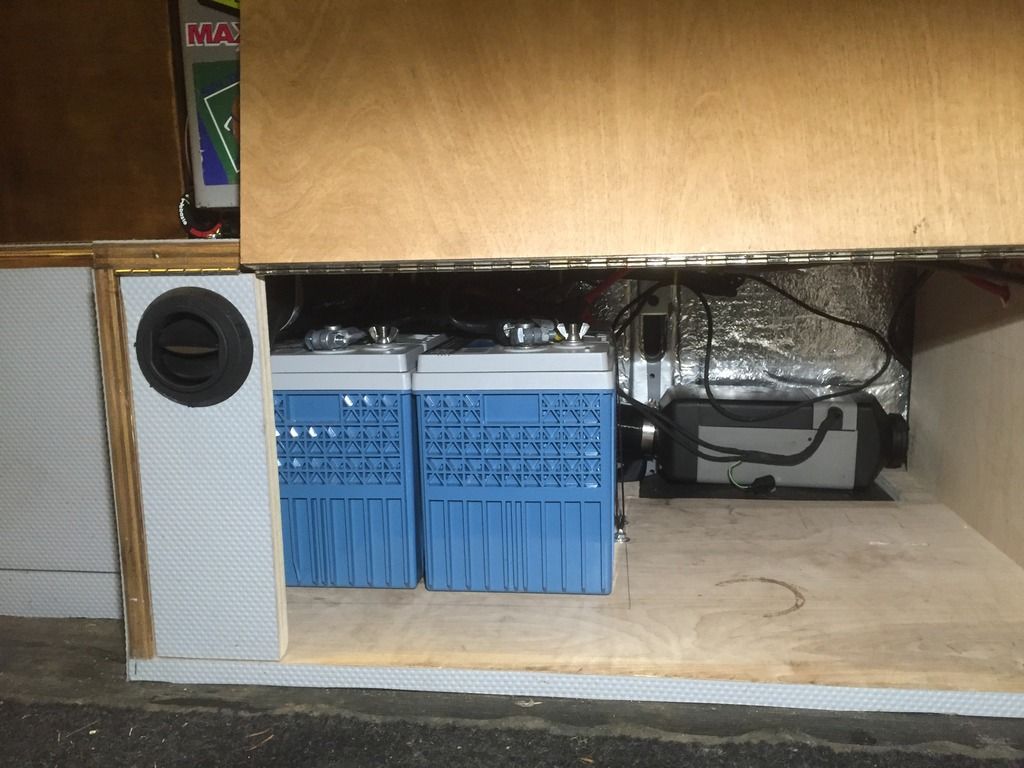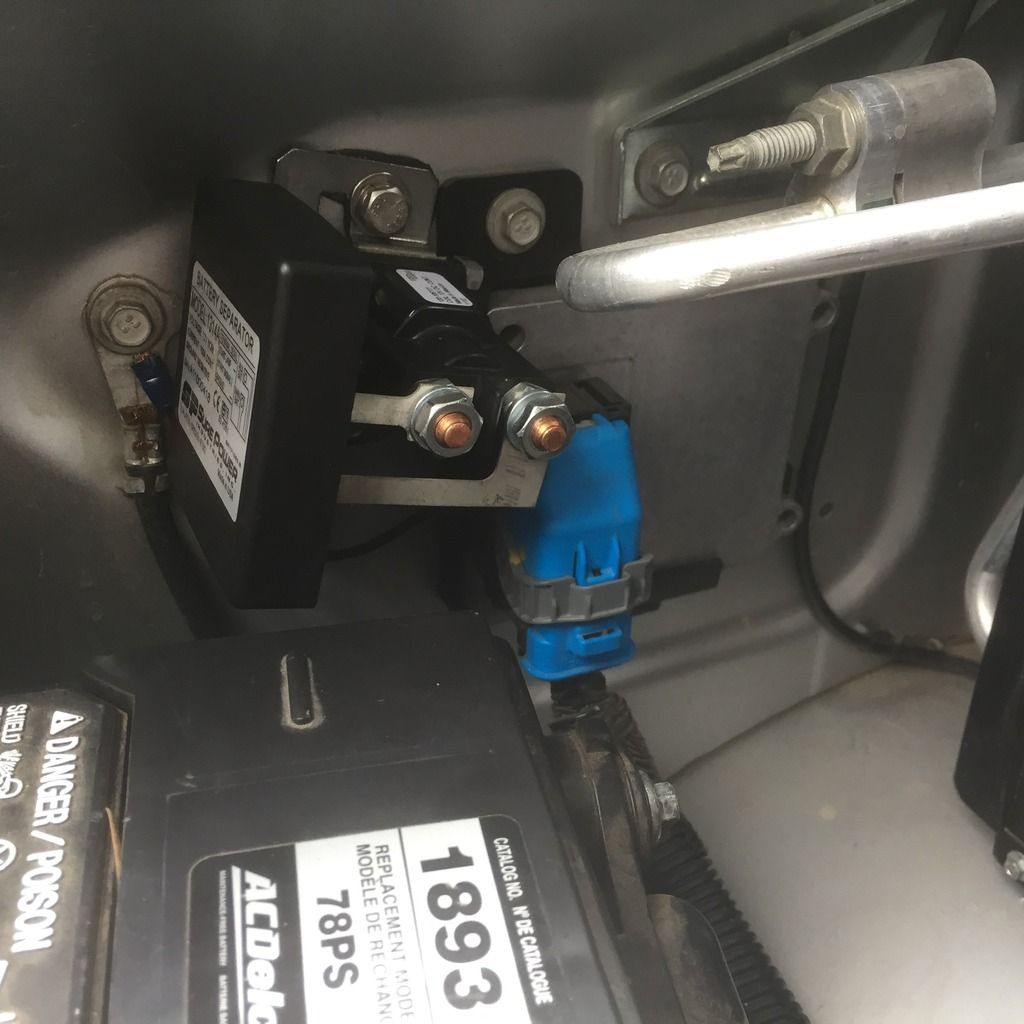iridewheelies
Adventurer
This weekend I noticed my alternator was putting out high voltage, over 15v. My house batteries are not supposed to be charged at over 15v so I am starting this thread to talk about the GM charging system and running a dual battery system. I'm also not satisfied with the way it charges while I'm driving and I think it can be improved.
What I have:
The Van - 2014 Express AWD, stock 125A alternator. No solar panels, yet.
Battery bank - 2 Sears Die Hard Platinum 31M in parallel. (These are rebranded Odyssey 31M-PC2150)
Battery separator - Sure Power 1314
The batteries are mounted inside my van, in a cabinet behind the driver's seat.

The battery separator is in the engine compartment next to the starting battery.

Batteries are grounded to the frame and the power is run with 4AWG to the battery separator through the firewall.
Here is the biggest problem. Odyssey Batteries are not supposed to be charged at over 15v according to the Odyssey tech document on the site here: http://www.odysseybattery.com/documents/US-ODY-TM-002_1214.pdf
on page 14 it says, "It is extremely important to ensure the charge voltage does not exceed 15V." But...
The GM power management will adjust the alternator to 15.5v in certain conditions. Here is the charging system description from the GM upfitter electrical guide found here - https://www.gmupfitter.com/files/media/photo/524/2014 GH Van Elec BBM SI Brief.pdf
*********************************************************************
*********************************************************************
Charging System Operation
The purpose of the charging system is to maintain the battery charge and vehicle loads. There are 6 modes of operation and they include:
• Battery Sulfation Mode
• Charge Mode
• Fuel Economy Mode
• Headlamp Mode
• Start Up Mode
• Voltage Reduction Mode
The engine control module (ECM) controls the generator through the generator turn ON signal circuit. The ECM monitors the generator performance though the generator field duty cycle signal circuit. The signal is a pulse width modulation (PWM) signal of 128 Hz with a duty cycle of 0–100 percent. Normal duty cycle is between 5–95 percent. Between 0–5 percent and 95– 100 percent are for diagnostic purposes. The following table shows the commanded duty cycle and output voltage of the generator:
Commanded Duty Cycle Generator Output Voltage
10% 11 V
20% 11.56 V
30% 12.12 V
40% 12.68 V
50% 13.25 V
60% 13.81 V
70% 14.37 V
80% 14.94 V
90% 15.5 V
The generator provides a feedback signal of the generator voltage output through the generator field duty cycle signal circuit to the ECM. This information is sent to the body control module (BCM). The signal is PWM signal of 128 Hz with a duty cycle of 0–
100 percent. Normal duty cycle is between 5–
99 percent. Between 0–5 percent and 100 percent are for diagnostic purposes.
*********************************************************************
*********************************************************************
The other problem I see is that when the GM charging system is at 40% or lower my Sure Power 1314 relay will open and no power goes to my house batteries. I see this as a problem because the battery bank will never be charged to 100%. The work around is to manually close the relay but I don't think that's a very good solution, I'll forget to open it back up and I don't want to leave the house battery and the starting battery connected together because they're different chemistries.
One possible solution might be to run the ground cable from the house battery bank to the engine compartment and tie into the starting battery ground. I think this might help because the GM power management is reading current and voltage with a donut (not sure what these are actually called) on the ground cable from the starting battery. The computer is making decisions based on the current going into the starting battery, it probably doesn't know the house batteries are there.
Any thoughts? How are you charging your house batteries in your GM vans?
What I have:
The Van - 2014 Express AWD, stock 125A alternator. No solar panels, yet.
Battery bank - 2 Sears Die Hard Platinum 31M in parallel. (These are rebranded Odyssey 31M-PC2150)
Battery separator - Sure Power 1314
The batteries are mounted inside my van, in a cabinet behind the driver's seat.

The battery separator is in the engine compartment next to the starting battery.

Batteries are grounded to the frame and the power is run with 4AWG to the battery separator through the firewall.
Here is the biggest problem. Odyssey Batteries are not supposed to be charged at over 15v according to the Odyssey tech document on the site here: http://www.odysseybattery.com/documents/US-ODY-TM-002_1214.pdf
on page 14 it says, "It is extremely important to ensure the charge voltage does not exceed 15V." But...
The GM power management will adjust the alternator to 15.5v in certain conditions. Here is the charging system description from the GM upfitter electrical guide found here - https://www.gmupfitter.com/files/media/photo/524/2014 GH Van Elec BBM SI Brief.pdf
*********************************************************************
*********************************************************************
Charging System Operation
The purpose of the charging system is to maintain the battery charge and vehicle loads. There are 6 modes of operation and they include:
• Battery Sulfation Mode
• Charge Mode
• Fuel Economy Mode
• Headlamp Mode
• Start Up Mode
• Voltage Reduction Mode
The engine control module (ECM) controls the generator through the generator turn ON signal circuit. The ECM monitors the generator performance though the generator field duty cycle signal circuit. The signal is a pulse width modulation (PWM) signal of 128 Hz with a duty cycle of 0–100 percent. Normal duty cycle is between 5–95 percent. Between 0–5 percent and 95– 100 percent are for diagnostic purposes. The following table shows the commanded duty cycle and output voltage of the generator:
Commanded Duty Cycle Generator Output Voltage
10% 11 V
20% 11.56 V
30% 12.12 V
40% 12.68 V
50% 13.25 V
60% 13.81 V
70% 14.37 V
80% 14.94 V
90% 15.5 V
The generator provides a feedback signal of the generator voltage output through the generator field duty cycle signal circuit to the ECM. This information is sent to the body control module (BCM). The signal is PWM signal of 128 Hz with a duty cycle of 0–
100 percent. Normal duty cycle is between 5–
99 percent. Between 0–5 percent and 100 percent are for diagnostic purposes.
*********************************************************************
*********************************************************************
The other problem I see is that when the GM charging system is at 40% or lower my Sure Power 1314 relay will open and no power goes to my house batteries. I see this as a problem because the battery bank will never be charged to 100%. The work around is to manually close the relay but I don't think that's a very good solution, I'll forget to open it back up and I don't want to leave the house battery and the starting battery connected together because they're different chemistries.
One possible solution might be to run the ground cable from the house battery bank to the engine compartment and tie into the starting battery ground. I think this might help because the GM power management is reading current and voltage with a donut (not sure what these are actually called) on the ground cable from the starting battery. The computer is making decisions based on the current going into the starting battery, it probably doesn't know the house batteries are there.
Any thoughts? How are you charging your house batteries in your GM vans?
